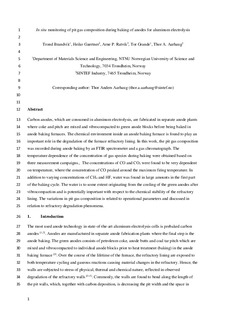In situ monitoring of pit gas composition during baking of anodes for aluminum electrolysis
Journal article, Peer reviewed
Accepted version

Åpne
Permanent lenke
http://hdl.handle.net/11250/2590790Utgivelsesdato
2019Metadata
Vis full innførselSamlinger
- Institutt for materialteknologi [2527]
- Publikasjoner fra CRIStin - NTNU [37703]
Originalversjon
Metallurgical and materials transactions. B, process metallurgy and materials processing science. 2019, 50 950-957. 10.1007/s11663-018-1500-8Sammendrag
Carbon anodes, which are consumed in aluminum electrolysis, are fabricated in separate anode plants where coke and pitch are mixed and vibrocompacted to green anode blocks before being baked in anode baking furnaces. The chemical environment inside an anode baking furnace is found to play an important role in the degradation of the furnace refractory lining. In this work, the pit gas composition was recorded during anode baking by a Fourier transformed infrared spectroscopy (FTIR) spectrometer and a gas chromatograph. The temperature dependence of the concentration of gas species during baking was obtained based on three measurement campaigns. The concentrations of CO and CO2 were found to be dependent on temperature, where the concentration of CO peaked around the maximum firing temperature. In addition to varying concentrations of CH4 and HF, water was found in large amounts in the first part of the baking cycle. The water originates to some extent from the cooling of the green anodes after vibrocompaction and is potentially important with respect to the chemical stability of the refractory lining. The variations in pit gas composition are related to operational parameters and are discussed in relation to refractory degradation phenomena.